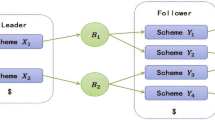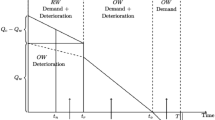Abstract
We study the stochastic inventory problem with optimal (s, S) policies. In a finite horizon model with lost sales, we establish new lower and upper bounds of s and S. These bounds have structural implications for the optimal solutions. Consequently, when demand has a generalized phase type distribution, there are no more than a pre-determined number of minima. Similar bounds can also be found for the system where unsatisfied demand is backordered instead of lost sales.
Similar content being viewed by others

References
Scarf H. The optimality of (s, S) policies in dynamic inventory problems [C]// Mathematical Methods in the Social Sciences, Stanford University, Stanford, USA. 1960: 83–96.
Iglehart D. Optimality of (s, S) policies in the infinite horizon dynamic inventory problems [J]. Management Science, 1963, 9(2): 259–267.
Veinott A F Jr. On the optimality of (s, S) inventory policies: New conditions and a new proof [J]. SIAM Journal on Applied Mathematics, 1966, 14(5): 1067–1083.
Porteus E L. On the optimality of generalized (s,S) policies [J]. Management Science, 1971, 17: 411–426.
Shreve S E. Abbreviated proof (in the lost sales case) [C]// Dynamic Programming and Stochastic Control, New York, USA. 1976: 105–106.
Veinott A F Jr, Wagner H M. Computing optimal (s, S) inventory policies [J]. Management Science, 1965, 11(5): 525–552.
Bashaym S, Fu M C. Optimization of (s, S) inventory systems with random lead times and a service level constraint [J]. Management Science, 1998, 44(12): 243–256.
Ehrhardt R. (s, S) policies for a dynamic inventory model with stochastic lead times [J]. Operations Research, 1984, 32(1): 121–132.
Hollier R H, Mak K L, Yiu K F C. Optimal inventory control of lumpy demand items using (s, S) policies with a maximum issue quantity restriction and opportunistic replenishments [J]. International Journal of Production Research, 2005, 43(23): 4929–4944.
Fox F J, Meters R, Semple J. Optimal inventory policy with two suppliers [J]. Operations Research, 2006, 54(2): 389–393.
Bensoussan A, Liu R H, Sethi P S P. Optimality of an (s, S) policy with compound Poisson and diffusion demands: A quasi-variational inequalities approach [J]. SIAM Journal on Control and Optimization, 2005, 44(5): 1650–1676.
Bensoussan A, Cakanyildirim M, Sethi S P. Optimality of base-stock and (s, S) policies for inventory problems with information delays [J]. Journal of Optimization Theory and Applications, 2006, 130(2): 153–172.
Hall G, Rust J. The (s, S) policy is an optimal trading strategy in a class of commodity price speculation problems [J]. Economic Theory, 2007, 30: 515–538.
Gürler U, Özkaya B Y. Analysis of the (s, S) policy for perishables with a random shelf life [J]. IIE Transactions, 2008, 40(8): 759–781.
Benkherouf L, Johnson M. On a stochastic demand jump inventory model [J]. SIAM Journal on Control and Optimization, 2009, 50(7–8): 1218–1228.
Pujawan I N, Silver E A. Augmenting the lot sizing order quantity when demand is probabilistic [J]. European Journal of Operational Research, 2008, 188(3): 705–722.
Federgruen A, Zipkin P. An efficient algorithm for computing optimal (s, S) policies [J]. Operations Research, 1984, 32(6): 1268–1285.
Zheng Y S, Federgruen A. Finding optimal (s, S) policies is about as simple as evaluating a single policy [J]. Operations Research, 1991, 39(4): 654–665.
Feng Y, Xiao B. A new algorithm for computing optimal (s,S) policies in a stochastic single item/location inventory system [J]. IIE Transactions, 2000, 32(11): 1081–1090.
Buzacott J A, Shanthikumar J G, Buzacott J A. Stochastic models of manufacturing systems [M]. New Jersey, USA: Prentice Hall, 1993: 156–162.
Lee H, Nahmias S. Single-product, single-location models [M]// De Kok A G, Graves S C. Handbooks in OR and MS, North-Holland: Elsevier Science, 1993: 3–55.
Author information
Authors and Affiliations
Corresponding author
Additional information
Communicated by JIAO Zheng
Project supported by the Shanghai Excellent Junior Faculty Foundation
About this article
Cite this article
Xu, Yy. New bounds of (s, S) policies in periodical review inventory systems. J. Shanghai Univ.(Engl. Ed.) 14, 111–115 (2010). https://doi.org/10.1007/s11741-010-0207-2
Received:
Revised:
Published:
Issue Date:
DOI: https://doi.org/10.1007/s11741-010-0207-2



